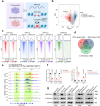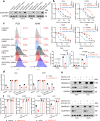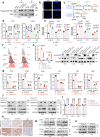Targeting ALDH16A1 mediated thioredoxin lysosomal degradation to enhance ferroptosis susceptibility in SMARCA4-deficient NSCLC
- PMID: 40897711
- PMCID: PMC12405490
- DOI: 10.1038/s41467-025-63687-6
Targeting ALDH16A1 mediated thioredoxin lysosomal degradation to enhance ferroptosis susceptibility in SMARCA4-deficient NSCLC
Abstract
Ferroptosis, an iron-dependent form of cell death, holds promise for cancer therapy. However, the intricate link between ferroptosis and oncogenic mutations remains unclear. Here we show that SMARCA4, a well-established tumour suppressor whose deficiency is associated with poor prognosis and resistance to treatments, sensitizes non-small cell lung cancer (NSCLC) cells to ferroptosis. Mechanistically, SMARCA4 promotes chromatin accessibility and expression of ALDH16A1. Surprisingly, ALDH16A1 lacks ALDH enzymatic activity, but binds to the anti-ferroptotic oxidoreductase thioredoxin (TXN), facilitating its translocation to the lysosome and subsequent degradation. Meanwhile, ALDH16A1 directly inhibits TXN's oxidoreductase function by occluding its active site. We also show that either restoring ALDH16A1 levels or inhibiting TXN significantly enhances the effectiveness of chemo/immunotherapy in a ferroptosis-dependent manner in SMARCA4-deficient NSCLC. Collectively, our findings elucidate an intricate SMARCA4-ALDH16A1-TXN stability/function dual regulatory axis that governs ferroptosis and informs a therapeutic strategy for overcoming resistance to chemotherapy or immunotherapy in SMARCA4-deficient NSCLC.
© 2025. The Author(s).
Conflict of interest statement
Competing interests: The authors declare no competing interests.
Figures







Similar articles
-
Genetic drivers of tumor microenvironment and immunotherapy resistance in non-small cell lung cancer: the role of KEAP1, SMARCA4, and PTEN mutations.J Immunother Cancer. 2025 Aug 5;13(8):e012288. doi: 10.1136/jitc-2025-012288. J Immunother Cancer. 2025. PMID: 40764107 Free PMC article. Review.
-
Promising efficacy of immune checkpoint inhibitor plus chemotherapy for thoracic SMARCA4-deficient undifferentiated tumor.J Cancer Res Clin Oncol. 2023 Sep;149(11):8663-8671. doi: 10.1007/s00432-023-04806-y. Epub 2023 Apr 28. J Cancer Res Clin Oncol. 2023. PMID: 37115272 Free PMC article.
-
SMARCA4 deficiency in small cell lung cancer: A case report and narrative review of the literature.Biomol Biomed. 2025 Jan 27;25(10):2394-2399. doi: 10.17305/bb.2024.11154. Biomol Biomed. 2025. PMID: 39888726 Review.
-
First-line combination therapy of immunotherapy plus anti-angiogenic drug for thoracic SMARCA4-deficient undifferentiated tumors in AIDS: a case report and review of the literature.Front Immunol. 2025 Jan 9;15:1473578. doi: 10.3389/fimmu.2024.1473578. eCollection 2024. Front Immunol. 2025. PMID: 39850892 Free PMC article. Review.
-
SMARCA4 controls state plasticity in small cell lung cancer through regulation of neuroendocrine transcription factors and REST splicing.J Hematol Oncol. 2024 Jul 30;17(1):58. doi: 10.1186/s13045-024-01572-3. J Hematol Oncol. 2024. PMID: 39080761 Free PMC article.
References
-
- Lei, G., Zhuang, L. & Gan, B. The roles of ferroptosis in cancer: tumor suppression, tumor microenvironment, and therapeutic interventions. Cancer Cell.42, 513–534 (2024). - PubMed
MeSH terms
Substances
Grants and funding
LinkOut - more resources
Full Text Sources
Medical
Miscellaneous

